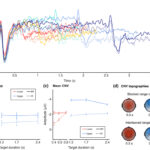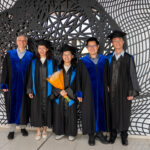Chen, S., Shi, Z., Müller, H. J., & Geyer, T. (2021). When visual distractors predict tactile search: The temporal profile of cross-modal spatial learning. Journal of Experimental Psychology. Learning, Memory, and Cognition. https://doi.org/10.1037/xlm0000993
Abstract
Contextual cueing refers to the guidance of search by associative learning of the location of task-relevant target items in relation to the consistent arrangement of distractor (“context”) items in the search display. The present study investigated whether such target-distractor associations could also be formed in a cross-modal search task in which the invariant distractor context is visual and the target is tactile. Each trial display consisted of 8 vibrotactile stimuli delivered to 4 fingers of each hand, with the target singled out by a vibrotactile feature difference relative to the homogeneous nontarget vibrations. In addition, there were 4 visual (Gabor) distractors and 4 empty circles colocated (on a different depth plane) with the vibrotactile stimuli. Crucially, in half of the trials, the location of the tactile target was associated with an identical (repeated) configuration, or “context,” of visual distractors. The results revealed facilitated RTs to the tactile targets when they were presented (250 to) 450 ms prior to—but not simultaneously with or after—a repeated visual distractor configuration, demonstrating a novel visuo-tactile contextual-cueing effect. Additional tests indicated that the optimal tactile preview period is broadly in line with the time required to recode the (initially) somatotopically sensed tactile stimuli into an external format shared with the visual items. We propose that, besides divided attention between the 2 modalities, the acquisition of search-guiding cross-modal context associations critically depends on the spatiotemporal colocation of the visuo-tactile stimuli.




